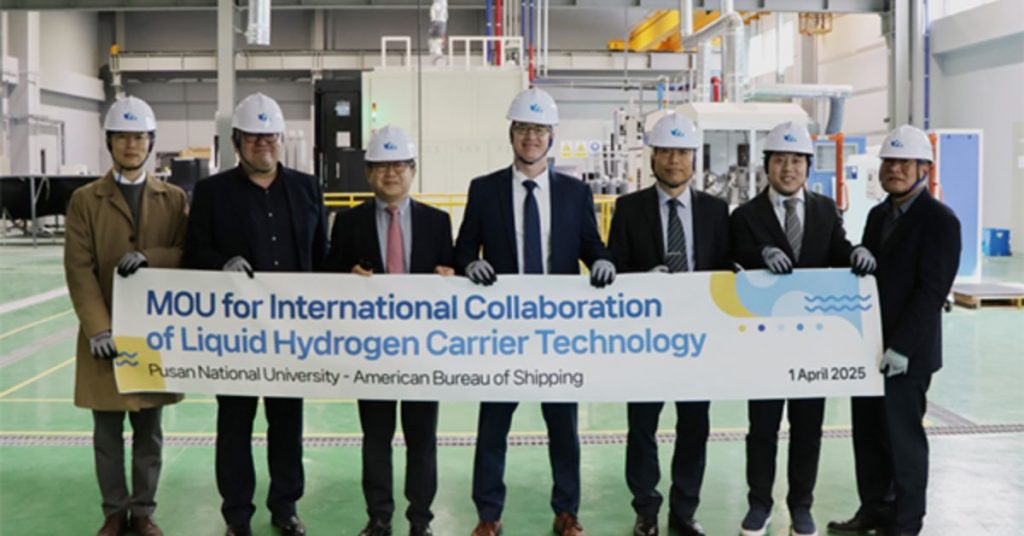The American Bureau of Shipping (ABS) has entered into a Memorandum of Understanding (MoU) with South Korea’s Pusan National University Hydrogen Ship Technology Center to jointly pursue advancements in liquid hydrogen carriers and cryogenic ship systems.
The collaboration brings together ABS’s global classification expertise with the center’s specialised knowledge in hydrogen technologies, aiming to overcome the technical challenges of hydrogen propulsion and large-scale maritime hydrogen transport. The initiative is seen as a critical step in developing the infrastructure needed to support a global hydrogen economy.
“By working together, we are confident we can deliver advances in the application of hydrogen technology at sea,” said Patrick Ryan, ABS Senior Vice President and Chief Technology Officer.
The Hydrogen Ship Technology Center, which has been appointed as the lead institution in South Korea’s national project for the “Development of Basic Technology for Commercialization of Liquid Hydrogen Carriers,” is playing a central role in the country’s broader “K-Shipbuilding Super Gap Vision 2040” strategy. This initiative includes the development of what could become the world’s largest vessel dedicated to transporting liquid hydrogen.
Transporting liquid hydrogen by sea poses unique technical hurdles. The substance must be stored at cryogenic temperatures near -253°C and requires highly specialised insulation and containment systems. Additionally, its relatively low volumetric energy density and the management of boil-off gas complicate efforts to scale maritime transport. To date, no commercial-scale liquid hydrogen carrier has been deployed.
Dr. Lee Jae-Myung, Director of the Hydrogen Ship Technology Center, emphasized the significance of the MoU, stating it would contribute to the “further advancement in the utilisation of liquid hydrogen… through differentiated international exchange activities based on world-class, ultra-low temperature technology.”
The agreement aligns with a broader global push to create viable pathways for hydrogen transport, particularly as countries look to meet decarbonisation goals and scale up hydrogen supply chains. Various approaches are being explored worldwide. For example, Japanese energy firm ENEOS is developing a liquid organic hydrogen carrier (LOHC) system with Honeywell, offering an alternative that allows hydrogen to be chemically bonded to a carrier liquid, removing the need for cryogenic storage.
While LOHCs can be moved using existing tanker fleets, they require additional processing infrastructure at both ends of the transport route to bind and release the hydrogen.
Innovations in hydrogen transport are also emerging in aviation. Researchers at the FAMU-FSU College of Engineering in Florida, USA, are developing a liquid hydrogen-based storage and delivery system tailored for zero-emission flight, focusing on improving thermal management and system integration.
Tags: ABS, Infrastructure, Maritime, Shipping, South Korea



Recent Posts
Hyundai Glovis to Retrofit Seven PCTCs with Avikus AI Navigation System
Super Terminais orders three more Konecranes Gottwald ESP.10 Mobile Harbor cranes
Covestro and HGK Shipping Extend Partnership to 2040 with Focus on Wind-Assisted Vessel Retrofit
Artemis Technologies Successfully Demonstrates 100 Percent Electric Crew Transfer Vessel at Aberdeen Offshore Wind Farm
IACS Council Advances Decarbonisation, Digitalisation and Governance Priorities at C91 Meeting in Beijing
Japan Launches Major R&D Project to Advance Shipbuilding with Alternative Fuels
EU Adopts Emissions Standards for Low Carbon Hydrogen to Bolster Clean Energy Market
Trafigura to Implement ZeroNorth’s AI Platform Across Global Fleet